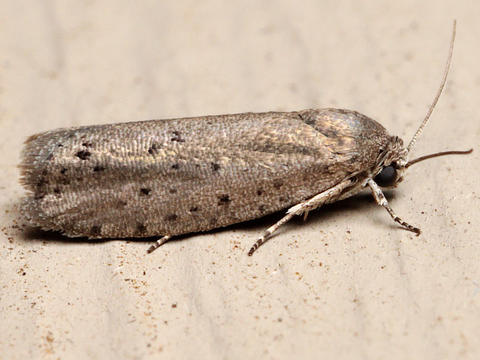A remnant of the local original landscape grows on a 4′ by 4′ area of my front yard near the road. It is known as sensitive briar (Mimosa microphilia), and it attracts numerous bees and other pollinators. Sensitive briar resembles its close relative, sunshine mimosa (M. strigillosa), but differs in that its vine is covered with thorns. These mimosas, native to southeastern North America, prefer to grow in prairies, ravines, savannahs, and open woods; and they do well on sandy or rocky soils. I live in a sandhill area located on the fall line between the piedmont and the coastal plain. The sandy soils originated during the Eocene when this region was a coast line and the fall line was a sandy beach. Today, the co-dominant trees are loblolly pine and sand laurel oak. Before humans repressed fires, it seems likely this area was dominated by longleaf pine with some sand laurel oak. Longleaf pine is slow-growing and dependent upon fire for germination, and it has largely been replaced in my neighborhood by faster growing, less fire-dependent loblolly pine. Also in the absence of fire, sand laurel oak forms dense stands on vacant lots when formerly they would be thermally pruned and grow farther apart. I hypothesize the original environment was open woodland or even savannah, dominated by the aforementioned trees and with a great variety of flowers and grasses growing in the open spaces between the trees. Other species in my neighborhood that might be remnants of this original environment include yellow cottony aster, a type of small daisy, prickly pear, ground cherry, blackberry, lowbush blueberry, false foxglove, and passion flower.
Sensitive briar growing in my front yard by the road.
The mimosa genus includes about 400 species of herbs, shrubs and trees within the legume family. The most commonly noticed mimosa in southeastern North America is Albizia julibrisson, a native from Asia and the Middle East. It was introduced to Charleston, South Carolina in 1783 and has spread like crazy all across the region. They are found in open areas alongside roads and are now considered an invasive species. I think they are more beneficial than detrimental. Their flowers feed the bees and butterflies, and their roots, like those of all legumes, help fix nitrogen in the soil. They are probably more beneficial than many of the native plants they outcompete. They produce numerous bean pods that readily germinate in road side ditches.
Mimosa trees are widespread and common in disturbed areas of the southeastern United States.
The mimosa genus is very old with a world wide distribution. They likely originated before the continents drifted apart. During the Pleistocene sensitive briar flourished in the open spaces that resulted from rapid climate change and megafauna foraging. However, there is no pollen or fossil evidence of this species from that age. Nevertheless, I’m sure they were common in some areas and just perchance left little evidence of their previous existence.
Plants in the mimosa genus are capable of rapid movement. Sensitive briar closes its leaves when being touched. Scientists think this response helps protect them from foraging herbivores, but they are vulnerable to at least 1 predator–the mimosa webworm (Homodaula anisocentra). The larva of this species wraps mimosa leaves inside a protective webbing which prevents the leaves from closing completely. They then feed upon the leaves before their transformation into their adult stage.
Mimosa webworm.
Tags: mimosa tree, mimosa webworm, sensitive briar



Leave a comment